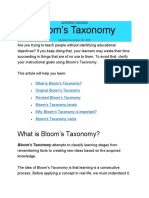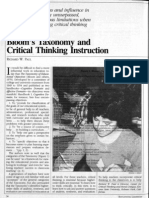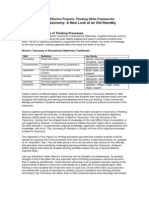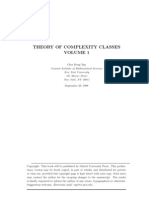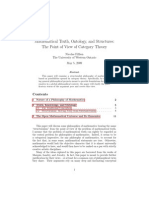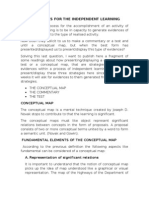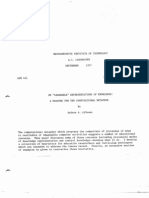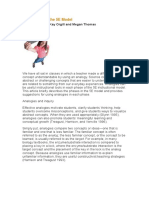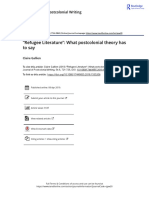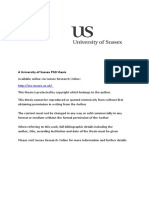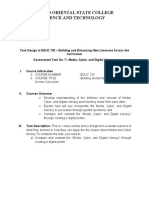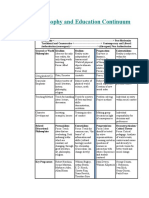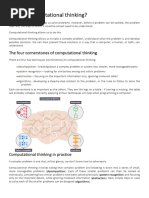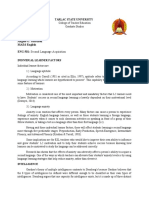A Basic Objection To Blooms Taxonomy
A Basic Objection To Blooms Taxonomy
Uploaded by
danielrubarajCopyright:
Available Formats
A Basic Objection To Blooms Taxonomy
A Basic Objection To Blooms Taxonomy
Uploaded by
danielrubarajOriginal Description:
Original Title
Copyright
Available Formats
Share this document
Did you find this document useful?
Is this content inappropriate?
Copyright:
Available Formats
A Basic Objection To Blooms Taxonomy
A Basic Objection To Blooms Taxonomy
Uploaded by
danielrubarajCopyright:
Available Formats
A Sketch of a More Basic Objection to Bloom's Taxonomy
Bloom's Taxonomy of Cognitive Objectives, articulated by Benjamin Bloom (and a task force swept up in his vision) in the early
50's, is usually neglected in current discussions of critical thinking theory, even though among schools of education and curriculum writers
it remains pervasively influential. Symptoms of this influence often include talk about "higher order thinking skills." Piaget's account of
cognitive development as generally a movement from concrete processing toward formal or abstract reasoning is sometimes cited as
justification for the approach (it sometimes also is taken as justification for taking formal logic as critical thinking).
One problem with Bloom's Taxonomy can be seen in the relation of the lowest level of thinking skills, memory, with those which
are allegedly higher. Laying this out requires we review the broad framework of the taxonomy, stressing the relationships among
abstractions and examples. I give the higher levels at the top, so first, though this reverses the alleged stages of cognitive development.
Evaluation is bringing a set of criteria to bear on an example. E.g. Critique the following lesson plan. (Followed by an example
of a lesson plan.)
Synthesis is putting together a work using elements dictated by a pre-existing framework or structure. E.g. Design a house to
take advantage of the resources available, consistent with the desires of the buyers, and in harmony with the site.
Analysis is providing an accounting of a whole by accounting for its parts, using a set of categories which label the kinds of
parts. E.g. Analyze Shakespeare's Hamlet as an Aristotelian tragedy.
Application is bringing an abstract theory's claims to bear on a particular example. E.g. Apply Freudian methods to the dream
Orestes tells of the eagle and the snake.
Interpretation is comparison and contrast of two works or sets of ideas, telling how they fit or do not fit each other, but using a
set of given topics or categories by which the two are to be compared. E.g. Compare and contrast the scene in which Cleopatra first
appears on stage in Shakespeare's play with the scene in which Jimmy Dean first appears in Giant, given a set of categories or ways in
which the two might be comparable (e.g., metaphors and similes, prosody, literary allusions, religious allusions).
Translation is changing the terms, mode, or language of given information. E.g. Graph the acceleration of the Dodge R/T and
the Volkswagen Beetle given the table of distances covered.
Memory is retaining and providing back information as given.
As a highly abstract theory about a mythological entity (“Cognitive Objectives”), Bloom’s Taxonomy exemplifies some of the
best and the worst results one finds when philosophy as conceptual analysis meets education. At that level, it’s probably untestable and
harmless, interesting in the way a Ptolemaic orrery might be interesting. Each level can be thought of as a concept nested within the one
below (except that analysis and synthesis are both within the concept of application), for instance. But those who talk about Bloom’s
Taxonomy often make the strategic mistake of supposing that it ought to be applicable, and it is often claimed to be useful in thinking
about teaching strategies and thinking about examination questions. It has become, then, a staple in teaching teachers and teaching study
skills to students. Further, it is after moves to apply it that we can get our hands on it and indicate its problems.
The taxonomy as given above (and in its main variants–sometimes there are six rather than seven categories) is used in study
skills classes to emphasize to students that all the “higher level skills” test questions can be regarded as having hidden agendas. If one is to
evaluate, one has to have the criteria to bring to bear, not make them up on the spot. If one is to synthesize, one has to know the kinds
of elements one is expected to put together into a new whole. If one is to analyze, one needs to know the categories or kinds of pieces
which are expected to result from the analysis. If one is to apply a theory, the methods and possible results are unstated parts of the
question. If one is to interpret, then one had better use the aspects or dimensions of interpretation which are to be used in these kinds of
cases. Translation in the sense used in the taxonomy requires one to bring mastery of a particular process to bear on original material.
Memory, then, is the only one in which some process which alters or generates something new is not brought to bear.
But another way to say this is that the higher level thinking skills crucially involve remembering the abstract categories which are
to be used, and remembering to use them. The analysis of the categories into higher and lower, with memory as the lowest of the low, is
thus seen as problematic, at least as used in thinking about exam questions and their answers.
One possible explanation for taking memory to be lower is that memory is always specific. A memory is a particular memory, a
memory of something at a particular time. But abstract categories do not always have this property. An ideal (e.g. as in James’ “The
Relevance of an Impossible Ideal”) is not necessarily a particular ideal; a flower, as a category, need not be a particular flower; and so on.
A prejudice in favor of abstraction, such as Bloom and Piaget share, will then prejudice one against memory, and perhaps incline one to
label it as a lower skill. This too, though, has problems when subjected to scrutiny. If one is to analyze a work of literature, and is to
master the higher level skills required, and so, say, comment on plays of this kind by addressing plot, characterization, tone, poetic
language, theme, and so on, what this means is that the student is to master the higher level skill by bringing those particular categories, or that
particular list to bear on the literary work. This remains true, by the way, even when one engages in this kind of analysis at another remove,
analyzing theories of criticism by applying to a work theories labeled as Marxist, New Critic, Critical Theory, Deconstructive, Freudian,
and so on, (some perhaps straw men) and then evaluating those theories using often obscure but crucial criteria for evaluating theories
which the student should endeavor to list or use as headings. –which brings us to:
Another possible explanation is that the higher skills are not taught so well, and students must teach themselves. That is, the
process of writing a research paper in a particular discipline might be the topic of a course for which students finally write a research
paper, a classic synthesis task. If the teacher models the process well, the student may come to realize on her own, without it ever having
been made explicit, that she needs to include, e.g., a literature survey, . . . a hypothesis, a conclusion. To the extent that the teacher does
not make the synthesizing process (or dimensions of comparision, or theory to be applied, or the list of analytic tools, or categories of
materials to synthesize, or the criteria of evaluation) a topic for overt teaching, then the teacher avoids making the task a memory task but
“teaches” the students to swim by throwing them in. Surely that must make it a higher level skill.
As such, these approaches (logic, Piaget, Bloom) leave unaddressed the issues regarding whether abstraction is more crucial to
education (or to philosophy) than is storytelling, say, or focusing on examples. This is an issue in which western civilization's convictions
might be compared with cultures in which parables and examples are taken to be primary. But it is also an issue which perhaps could be
approached through investigating Piaget and Bloom's Taxonomy and philosophical work regarding the place of examples in
understanding..
jwp2@humboldt.edu
You might also like
- A First Course in Topology: An Introduction to Mathematical ThinkingFrom EverandA First Course in Topology: An Introduction to Mathematical ThinkingNo ratings yet
- Bloom's TaxonomyDocument12 pagesBloom's TaxonomyIro Niel De sagun PANOLNo ratings yet
- Z. Bloom's Taxonomy - Revised Levels, Verbs For Objectives (2023)Document12 pagesZ. Bloom's Taxonomy - Revised Levels, Verbs For Objectives (2023)J M Prieto PNo ratings yet
- Blooms Taxonomy With QuizDocument9 pagesBlooms Taxonomy With QuizJorlyn MajadasNo ratings yet
- BloomsDocument6 pagesBloomslykapuno3No ratings yet
- Types of Students' Justifications: Resumen (Abstract)Document7 pagesTypes of Students' Justifications: Resumen (Abstract)Luis DíazNo ratings yet
- Bloom's Taxonomy and Critical ThinkingDocument5 pagesBloom's Taxonomy and Critical ThinkingdistanceprepNo ratings yet
- fshowDocument12 pagesfshowjhaceyuzovchiNo ratings yet
- CH 7 Teaching SociologyDocument20 pagesCH 7 Teaching SociologyOlena DiadikovaNo ratings yet
- Understanding Bloom Reading and WritingDocument8 pagesUnderstanding Bloom Reading and WritingNisreen OmarNo ratings yet
- Bloom's TaxonomyDocument4 pagesBloom's TaxonomyNADIA ELIZABETH CUEVAS JIMENEZNo ratings yet
- Blooms TaxonomyDocument16 pagesBlooms TaxonomyBaden BueNo ratings yet
- 2 Macdld PDFDocument9 pages2 Macdld PDFKhairul IksanNo ratings yet
- Whetten - What Constitutes To A Theoretical ContributionDocument7 pagesWhetten - What Constitutes To A Theoretical ContributionJonathan ReddyNo ratings yet
- From The Margins To The MainstreamDocument2 pagesFrom The Margins To The MainstreamLucasGhilardiNo ratings yet
- Text Rhetorical ModesDocument3 pagesText Rhetorical Modes4sp ps4No ratings yet
- What Is A THEORYDocument5 pagesWhat Is A THEORYJan Allen LumiquedNo ratings yet
- New Blooms TaxonomyDocument5 pagesNew Blooms TaxonomyJohnnyboy SalemNo ratings yet
- ICMIPaper Apos (Ing)Document22 pagesICMIPaper Apos (Ing)Yuliana TobingNo ratings yet
- Advanced Mathematical Thinking at Any AgeDocument24 pagesAdvanced Mathematical Thinking at Any AgeskyNo ratings yet
- Theory of Complexity Classes - Yap (1998)Document435 pagesTheory of Complexity Classes - Yap (1998)daveparag100% (1)
- 3 DocDocument7 pages3 DocSebastian GaonaNo ratings yet
- 01 - A - Curriculum Theory - Meaning Development and UseDocument6 pages01 - A - Curriculum Theory - Meaning Development and UsezhraannisaaaNo ratings yet
- Lectura 2 - What Constitutes A Theoretical ContributionDocument6 pagesLectura 2 - What Constitutes A Theoretical ContributionJov Mies RautaNo ratings yet
- Student S Sucess or FailureDocument9 pagesStudent S Sucess or FailureGraecus1No ratings yet
- Writing Clear Paragraphs: Research and Learning Online (HTTPS://WWW - Monash.Edu/Rlo)Document90 pagesWriting Clear Paragraphs: Research and Learning Online (HTTPS://WWW - Monash.Edu/Rlo)Abu SayemNo ratings yet
- Academic English Week 1Document29 pagesAcademic English Week 1Sohaib SheikhNo ratings yet
- A Critical Appraisal of Bloom's Taxonomy - 2016Document9 pagesA Critical Appraisal of Bloom's Taxonomy - 2016WahyudiUkswSalatigaNo ratings yet
- The Stand-Alone Learning StrategiesDocument12 pagesThe Stand-Alone Learning StrategiesromeromauricioNo ratings yet
- Chapter 5 Rethorical ModesDocument8 pagesChapter 5 Rethorical ModesPaula Luciana DumraufNo ratings yet
- The Anthropology of DidacticsDocument12 pagesThe Anthropology of DidacticsHarnel peñaNo ratings yet
- Understanding AnalysisDocument2 pagesUnderstanding AnalysisElham Zogheib20% (5)
- Understanding The Limit Concept: Beginning With A Coordinated Process SchemaDocument23 pagesUnderstanding The Limit Concept: Beginning With A Coordinated Process SchemaVilmar FonsecaNo ratings yet
- Bernadette A. Divinagracia: Bloom's TaxonomyDocument9 pagesBernadette A. Divinagracia: Bloom's TaxonomydenizsadayNo ratings yet
- Behavioural: Cognitive: The Most-Used of The Domains, Refers To Knowledge Structures (AlthoughDocument4 pagesBehavioural: Cognitive: The Most-Used of The Domains, Refers To Knowledge Structures (AlthoughRexieR.FrịasNo ratings yet
- Children at School Research Their Local Environment.: Activity I.1Document105 pagesChildren at School Research Their Local Environment.: Activity I.1Sohail AhmadNo ratings yet
- Beyond Constructivism: Mathematical Thinking and Learning April 2003Document6 pagesBeyond Constructivism: Mathematical Thinking and Learning April 2003Franklin EinsteinNo ratings yet
- Fillion, Mathematical Truth, Ontology and Structures Category TheoryDocument15 pagesFillion, Mathematical Truth, Ontology and Structures Category Theoryflores3831_814460512100% (2)
- RESEDocument6 pagesRESEfelixiefairyNo ratings yet
- 1 Lawn - Introduction To Methodology PDFDocument12 pages1 Lawn - Introduction To Methodology PDFnikite nirmalaNo ratings yet
- Zusammenfassung Dissertation WohinDocument5 pagesZusammenfassung Dissertation WohinBuyResumePaperUK100% (1)
- Educ 36Document6 pagesEduc 36Kevinboy MondeloNo ratings yet
- AG ED 423/623: Curriculum TheoryDocument45 pagesAG ED 423/623: Curriculum TheoryBernie PlantillaNo ratings yet
- Part Ni DiazDocument4 pagesPart Ni DiazLydia AlbanNo ratings yet
- StructuresofproofsDocument9 pagesStructuresofproofsmastmulla921No ratings yet
- Strategies For The Independent LearningDocument9 pagesStrategies For The Independent Learningnoralba89No ratings yet
- Teaching Literary AnalysisDocument4 pagesTeaching Literary AnalysisemanNo ratings yet
- Disessa 1979 - LearnabilityDocument42 pagesDisessa 1979 - Learnabilitypratim1No ratings yet
- Philosophivalinquiry in Teacher EducationDocument35 pagesPhilosophivalinquiry in Teacher EducationHilux23No ratings yet
- A Definition of Conceptual UnderstandingDocument2 pagesA Definition of Conceptual UnderstandingzatulfahimaNo ratings yet
- Conics Section ModuleDocument42 pagesConics Section ModuleDorotheaNo ratings yet
- Research ConstructivismDocument7 pagesResearch Constructivismmaribel anganaNo ratings yet
- Solomon Feferman: Inappropriate For Inadequate For The FullDocument11 pagesSolomon Feferman: Inappropriate For Inadequate For The FullHenrique97489573496100% (1)
- Dual Coding Theoy PaivioDocument62 pagesDual Coding Theoy PaivioAntonio José Cruz FilhoNo ratings yet
- Report RWDocument6 pagesReport RWRonan TreyesNo ratings yet
- Analogies and The 5E ModelDocument10 pagesAnalogies and The 5E ModelShiNtaEsdEemNo ratings yet
- Essay Nurgali RabigaDocument1 pageEssay Nurgali RabigaKyroko FairyNo ratings yet
- Dot1975a Long Term LearningDocument16 pagesDot1975a Long Term LearningAlekseyevich GagarinNo ratings yet
- Level of Questioning in TestDocument2 pagesLevel of Questioning in TestLuis Jr. AzulNo ratings yet
- Tamil Cultural Elites and CinemaDocument7 pagesTamil Cultural Elites and CinemadanielrubarajNo ratings yet
- Hegemonic MasculinityDocument1 pageHegemonic MasculinitydanielrubarajNo ratings yet
- An Analysis To Edgar Allan Poes The RaveDocument19 pagesAn Analysis To Edgar Allan Poes The RavedanielrubarajNo ratings yet
- American Madura Mission - Statistical Tables 1932Document16 pagesAmerican Madura Mission - Statistical Tables 1932danielrubarajNo ratings yet
- Disjunction and Difference in The Global Cultural EconomyDocument5 pagesDisjunction and Difference in The Global Cultural Economydanielrubaraj100% (1)
- Literary Theory and Criticism: Cultural Materialism, Othello and The Politics of Plausibility by Alan SinfieldDocument10 pagesLiterary Theory and Criticism: Cultural Materialism, Othello and The Politics of Plausibility by Alan SinfielddanielrubarajNo ratings yet
- Refugee Literature What Postcolonial Theory Has To SayDocument7 pagesRefugee Literature What Postcolonial Theory Has To SaydanielrubarajNo ratings yet
- University of Sussex Homing Diaspora - Diasporizing Home - Locating South Asian DiasporicDocument183 pagesUniversity of Sussex Homing Diaspora - Diasporizing Home - Locating South Asian DiasporicdanielrubarajNo ratings yet
- Far From The Madding Crowd SummaryDocument1 pageFar From The Madding Crowd SummarydanielrubarajNo ratings yet
- English in The Indian DiasporaDocument255 pagesEnglish in The Indian DiasporadanielrubarajNo ratings yet
- Swarnabhoomi Plot Price 1 (REVISED)Document18 pagesSwarnabhoomi Plot Price 1 (REVISED)danielrubarajNo ratings yet
- Blended Learning: A New Hybrid Teaching Methodology: ISSN: 2456-8104 JRSP-ELT, Issue 13, Vol. 3, 2019Document6 pagesBlended Learning: A New Hybrid Teaching Methodology: ISSN: 2456-8104 JRSP-ELT, Issue 13, Vol. 3, 2019danielrubarajNo ratings yet
- NDLI CLUB Registration Process: Website: Https://club - Ndl.iitkgp - Ac.in/club-Home Support EmailDocument27 pagesNDLI CLUB Registration Process: Website: Https://club - Ndl.iitkgp - Ac.in/club-Home Support Emaildanielrubaraj0% (1)
- Mba Master Business Administration PDFDocument3 pagesMba Master Business Administration PDFdanielrubarajNo ratings yet
- Madurai Kamaraj University: M.Phil. / Ph.D. Regulations Effective 5 May 2016Document22 pagesMadurai Kamaraj University: M.Phil. / Ph.D. Regulations Effective 5 May 2016danielrubarajNo ratings yet
- Sample Tarp Research Congress Practical 1Document1 pageSample Tarp Research Congress Practical 1Kearly Joy VictorioNo ratings yet
- Resume For WebsiteDocument1 pageResume For Websiteapi-284496953No ratings yet
- LAYOUT OF SEQUENCE 01 MS3 From Teachers - GuideDocument26 pagesLAYOUT OF SEQUENCE 01 MS3 From Teachers - GuideToufik GhriciNo ratings yet
- Davao Oriental State College of Science and TechnologyDocument5 pagesDavao Oriental State College of Science and TechnologySitti Shalyn ArimaoNo ratings yet
- Les On Plan ModifyDocument10 pagesLes On Plan ModifyKatherine Buhia AleoNo ratings yet
- GriffithS - EDID6506 Assign2 2Document22 pagesGriffithS - EDID6506 Assign2 2Tj ShmurdaNo ratings yet
- DLP Module 1 W3 (1st Semester) P.E. and Health 11Document3 pagesDLP Module 1 W3 (1st Semester) P.E. and Health 11Marisol TapadoNo ratings yet
- ED616912Document14 pagesED616912Abdelghani BanaouiNo ratings yet
- Subject Assignment: Approaches To LanguageDocument12 pagesSubject Assignment: Approaches To LanguageAngela Arroyave HernandezNo ratings yet
- Kristin Hensley Week 2 Assignment Assessment For ReadingDocument11 pagesKristin Hensley Week 2 Assignment Assessment For ReadingKristin HensleyNo ratings yet
- Facilitating Learner-Centered Teaching: Module 3 - Review of Theories Related To The Learners' DevelopmentDocument15 pagesFacilitating Learner-Centered Teaching: Module 3 - Review of Theories Related To The Learners' DevelopmentLou Jane YescaNo ratings yet
- Philosophy and Education Continuum Chart: Originator(s)Document2 pagesPhilosophy and Education Continuum Chart: Originator(s)Umme Ammara100% (1)
- Teachers' Perceptions of Effective Strategies For Teaching Literature To Enhance BEED Students' LearningDocument6 pagesTeachers' Perceptions of Effective Strategies For Teaching Literature To Enhance BEED Students' LearningnylanehrNo ratings yet
- 8609.2.ghulam MustafaDocument14 pages8609.2.ghulam MustafaGM raimaths techNo ratings yet
- UTD Academic Calendar Spring 2019Document2 pagesUTD Academic Calendar Spring 2019AlexNo ratings yet
- Magsaysay Avenue, Barangay Dadiangas West, General Santos CityDocument1 pageMagsaysay Avenue, Barangay Dadiangas West, General Santos CityJan Vincent A. LadresNo ratings yet
- BBC. Introduction To Computational ThinkingDocument3 pagesBBC. Introduction To Computational ThinkingMonica LamaNo ratings yet
- 5e Lesson Plan Template - GroupDocument7 pages5e Lesson Plan Template - Groupapi-457712711No ratings yet
- Artificial Intelligence Chapter 1: Introduction: Michael Scherger Department of Computer Science Kent State UniversityDocument30 pagesArtificial Intelligence Chapter 1: Introduction: Michael Scherger Department of Computer Science Kent State UniversityHeather YatesNo ratings yet
- Education InequalityDocument3 pagesEducation Inequalityarqam hussainNo ratings yet
- Individual Learner Factors and IntelligenceDocument2 pagesIndividual Learner Factors and IntelligenceLora CunananNo ratings yet
- Maths at Lido Learning:: Build Problem Solving SkillsDocument16 pagesMaths at Lido Learning:: Build Problem Solving SkillsShradha R BinuNo ratings yet
- Teacher Interview QuestionsDocument2 pagesTeacher Interview Questionswube gobeNo ratings yet
- TLE-Sep 19Document2 pagesTLE-Sep 19Ladyjobel Busa-RuedaNo ratings yet
- Teacher Belief StatementDocument5 pagesTeacher Belief Statementapi-269268563No ratings yet
- "Developing Competence and Creating Opportunities": General Santos City National Secondary School of Arts and TradesDocument3 pages"Developing Competence and Creating Opportunities": General Santos City National Secondary School of Arts and TradesFranz Kayl AlgarmeNo ratings yet
- Student ProfileDocument2 pagesStudent Profileapi-571568290No ratings yet
- Week 2Document6 pagesWeek 2ROMY JOHN SALVACION BONTANONNo ratings yet
- Ball, DDocument8 pagesBall, DMauricio SalazarNo ratings yet
- Least Mastered in Oral Communication in Context This Second QuarterDocument23 pagesLeast Mastered in Oral Communication in Context This Second QuarterSVPSNo ratings yet

